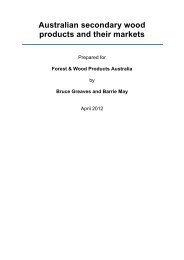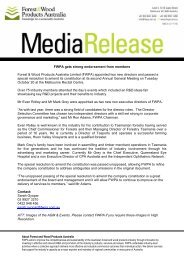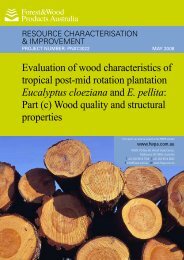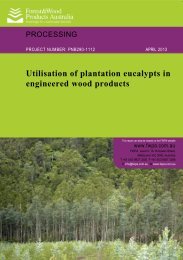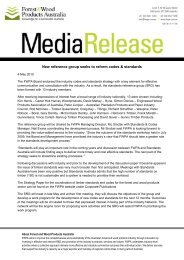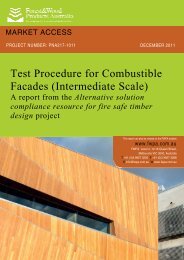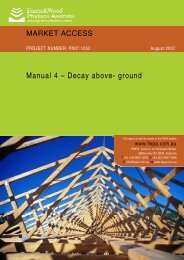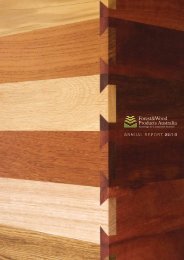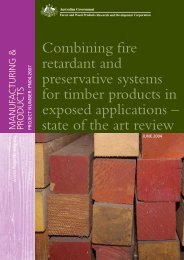Predicting the water-use of Eucalyptus nitens plantations in ...
Predicting the water-use of Eucalyptus nitens plantations in ...
Predicting the water-use of Eucalyptus nitens plantations in ...
Create successful ePaper yourself
Turn your PDF publications into a flip-book with our unique Google optimized e-Paper software.
975 mm/yr dur<strong>in</strong>g <strong>the</strong> experiment. The ratios <strong>of</strong> ra<strong>in</strong>fall to potential evaporation suggest that<br />
<strong>the</strong> site is seasonally <strong>water</strong>-limited but anecdotal evidence suggests that, dur<strong>in</strong>g dry summer<br />
periods, <strong>the</strong> trees have access to ground <strong>water</strong>, and that <strong>the</strong>ir overall annual <strong>water</strong>-<strong>use</strong> is<br />
consistent with that <strong>of</strong> <strong>plantations</strong> grow<strong>in</strong>g on a non-<strong>water</strong>-limited site. Roberts (2011A)<br />
provides a full description <strong>of</strong> <strong>the</strong> <strong>plantations</strong> and <strong>the</strong> results from this experiment.<br />
Estimates <strong>of</strong> annual and monthly basal area, canopy <strong>in</strong>terception, soil evaporation and<br />
transpiration were made dur<strong>in</strong>g <strong>the</strong> study (Roberts, 2011). The purpose <strong>of</strong> <strong>the</strong>se estimates<br />
was to generate estimates <strong>of</strong> annual <strong>water</strong>-<strong>use</strong> for adjacent <strong>plantations</strong> <strong>of</strong> different age and<br />
basal area, with a view to develop<strong>in</strong>g <strong>water</strong>-<strong>use</strong> functions that could be <strong>use</strong>d <strong>in</strong> <strong>the</strong> FEM.<br />
Only annual data are shown <strong>in</strong> this report as this is <strong>the</strong> temporal scale <strong>of</strong> <strong>the</strong> FEM. Data<br />
could be disaggregated to smaller time <strong>in</strong>tervals if <strong>the</strong>y were required for o<strong>the</strong>r <strong>use</strong>s.<br />
The amount <strong>of</strong> <strong>water</strong>-<strong>use</strong>d by <strong>the</strong> <strong>plantations</strong>, and <strong>the</strong> proportions <strong>of</strong> this total <strong>use</strong>d by <strong>the</strong><br />
different <strong>water</strong>-<strong>use</strong> processes (transpiration, canopy <strong>in</strong>terception and soil evaporation), varied<br />
with age (Figure 2). Figure 2 shows <strong>the</strong> annual canopy <strong>in</strong>terception, soil evaporation and<br />
transpiration associated with each plantation for each year, and <strong>the</strong> th<strong>in</strong>n<strong>in</strong>g status <strong>of</strong> <strong>the</strong><br />
plantation.<br />
In a plantation less than 1-year-old, soil evaporation was <strong>the</strong> dom<strong>in</strong>ant process, account<strong>in</strong>g<br />
for 376 mm/yr, while transpiration and canopy <strong>in</strong>terception comb<strong>in</strong>ed only accounted for 168<br />
mm/yr. In an 11-year-old unth<strong>in</strong>ned plantation, transpiration (445 mm/yr) and canopy<br />
<strong>in</strong>terception (379 mm/yr) were <strong>the</strong> dom<strong>in</strong>ant processes, with soil evaporation just 40 mm/yr.<br />
Th<strong>in</strong>n<strong>in</strong>g reduced canopy <strong>in</strong>terception and transpiration, from around 1000 mm/yr <strong>in</strong> an<br />
unth<strong>in</strong>ned stand to around 660 mm/yr, while markedly <strong>in</strong>creas<strong>in</strong>g soil evaporation, from an<br />
unth<strong>in</strong>ned value <strong>of</strong> around 40 mm/yr to a th<strong>in</strong>ned value <strong>of</strong> 120-200 mm/yr.<br />
Annual <strong>water</strong>-<strong>use</strong> was thus l<strong>in</strong>ked to <strong>the</strong> age <strong>of</strong> unth<strong>in</strong>ned <strong>plantations</strong> (R 2 =0.68; Figure 3),<br />
and also th<strong>in</strong>n<strong>in</strong>g status (Figure 3). The th<strong>in</strong>ned data set doesn’t span enough years to allow<br />
analysis over time.<br />
In 2010 all <strong>plantations</strong> recorded lower than anticipated <strong>water</strong>-<strong>use</strong>. This is probably beca<strong>use</strong><br />
lower than average ra<strong>in</strong>fall (984 mm) and lower than average potential evaporation (887 mm)<br />
occurred <strong>in</strong> 2010. Some <strong>of</strong> <strong>the</strong> variation <strong>in</strong> <strong>the</strong> relationship between annual <strong>water</strong>-<strong>use</strong> and age<br />
thus appears to be due to environmental conditions experienced dur<strong>in</strong>g <strong>the</strong> year <strong>of</strong><br />
measurement. Water-<strong>use</strong> <strong>of</strong> <strong>plantations</strong> <strong>of</strong> <strong>the</strong> same age could <strong>the</strong>refore vary between years.<br />
Fur<strong>the</strong>rmore, plantation growth is also a function <strong>of</strong> <strong>the</strong> conditions experienced throughout<br />
<strong>the</strong> entire life-cycle <strong>of</strong> <strong>the</strong> plantation, and some <strong>plantations</strong> orig<strong>in</strong>ated dur<strong>in</strong>g periods with<br />
better conditions than o<strong>the</strong>rs and hence had greater density, leaf area and/or basal area for a<br />
given age. Thus, unth<strong>in</strong>ned Plantation 20A had lower <strong>water</strong>-<strong>use</strong> <strong>in</strong> 2008 than younger and<br />
older unth<strong>in</strong>ned <strong>plantations</strong> <strong>in</strong> that year, which may <strong>in</strong>dicate that this plantation has a lower<br />
leaf area or growth rate than o<strong>the</strong>r <strong>plantations</strong> due ei<strong>the</strong>r to site quality or <strong>the</strong> conditions<br />
experienced <strong>in</strong> its early life.<br />
5



